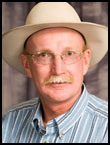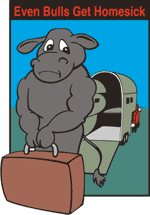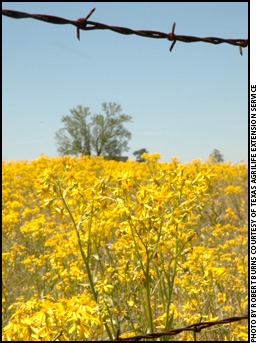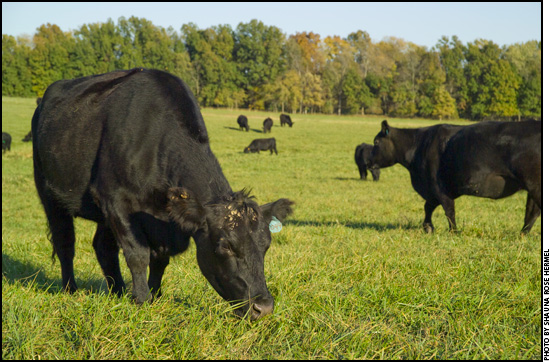MANAGEMENT...
Match Cows to Forage Resources
Performance predictors offer assistance in selecting appropriate milk levels, growth and carcass considerations.
Commercial cow-calf operators must become more cost-efficient to maintain or improve profit margins, making matching animals to forage resources more important than ever. Land, fertilizer, feed, fuel and labor costs continue to increase relative to the value of carcass beef and weaned calves, reminds David Lalman, Oklahoma State University (OSU) professor of animal science.
"One logical solution is to select and breed cattle that are productive in a given environment while requiring minimal labor and supplemental feed inputs," he says.
Lalman discusses how producers can use planned crossbreeding systems and genetic prediction tools to increase efficiency if they don't chase extremes. And we've added some helpful resources provided by the American Angus Association to members and commercial cattlemen. Read more.

Ron Torell
Back to Basics
Docility
The older I get, the more I enjoy being around docile people and cattle. Life is easier that way. For example, my wife of 35 years is generally a docile, calm and collected person. By her own admission, however, she can get worked up and on the hook. She insists it is her Italian heritage, but it may be I just know which buttons to push and how or when to push those buttons.
Cattle are the same way. I don't want to infer that we want our range cows to act like two-step farmer cows (take two steps and stop). We need our range cows to step out and cover the country when asked to. At the same time, we need to be able to approach our cattle and handle them without a fight while not having concerns for our safety. In this installment of "Back to Basics," let's discuss the benefits of breeding and handling our cattle with docility in mind. Let's review some of the published research that has been done in this area. Read more.
Five Tips to Fine-Tune Forage Management
When it comes to profitability, forage gurus Garry Lacefield with the University of Kentucky and Don Ball with Auburn University say it's a simple equation to remember: "Income minus expense equals profitability," Lacefield says.
He adds, "With rising input costs, it's difficult to make a profit in the livestock business. So, if things aren't going like you want, you've got to make some changes."
Recognizing that, Lacefield and Ball tell producers to focus on the areas that they can control. "You can't control the weather. So think about the areas that you do have control over and can fine-tune," Lacefield says. Read more.
Tongue Twister
Cows like leaves their tongues can wrap around easily.
Lots of leaves growing in easy reach of a cow's tongue means less time and less land needed to raise beef cattle, according to Agricultural Research Service (ARS) and DairyNZ (New Zealand) scientists.
Ranchers may be able to tell how long to leave cattle in a pasture, and how large to make the pasture, by the height and leafiness of plants growing there, according to Stacey Gunter, research leader at the ARS Southern Plains Range Research Station in Woodward, Okla. He worked with former doctoral student Pablo Gregorini and colleagues at Woodward to demonstrate this approach with beef steers grazing in fenced-off corridors in wheat pastures. Read more.

Kris Ringwall
Beef Talk
Adapt new bulls to their new home slowly.
 After a spring of bull shopping, the first thing one realizes is there are a lot of good bulls on the market. The strong selection makes for fun shopping.
After a spring of bull shopping, the first thing one realizes is there are a lot of good bulls on the market. The strong selection makes for fun shopping.
The second obvious point has to do with soundness. Sound bulls are structurally correct and blend with their environment. In fact, bulls are products of their environment.
The best way to treat new bulls is to place them in an environment similar to the one they came from. While a smooth transition is important, this is not always possible. Read more.
Weeds, Weeds, Weeds

Cutbacks of fertilizer on Bermuda grass pastures mean beef producers are seeing more cool-season weeds such as Texas groundsel, according to a Texas AgriLife Extension Service forage specialist.
Forage specialist offers tips on how to prevent, eliminate bothersome weeds.
Beef producers throughout Texas are having problems with cool-season weeds and will likely have problems with warm-season annual weeds as the year progresses, according to reports from Texas AgriLife Extension Service personnel. Though it's not a crisis situation, it is a prevalent one reported by AgriLife Extension agents in many counties in the last few weeks.
While many producers may suspect the unusually wet winter and spring to be behind the flush of weeds, the most likely cause, particularly when it comes to improved pastures, is a poor fertility program, says Vanessa Corriher. The Texas AgriLife Extension forage specialist offers tips for how to prevent, identify and eliminate bothersome weeds. Read more.
Wheat Stripe Rust, Leaf Rust Found in Texas Wheat
K-State to host May 3 webinar for growers, applicators, others.
Several cases of severe leaf rust and stripe rust in wheat were found in multiple locations around College Station, Texas, during March — even in some varieties thought to be resistant to the disease. Those varieties, said Kansas State University plant pathologist Erick DeWolf, include Fuller, Santa Fe, Art, Overley, Jagger and Jagalene. Wheat disease specialists and breeders are working to determine if the reports represent an underlying change in the stripe rust population within the region. Read more.
New Products
Industry affiliates provide a wide array of products and services to assist you on the farm and ranch. Here's an assortment of new products to hit the market recently.
• Innovations in livestock trailer design
• Flex-wing cutter for small horsepower tractors
• Expanded cutterbar warranty protection
• Second series of auto-darkening welding helmets
Angus Advisor
Click here for April herd management tips from cattle experts across the nation. Advice separated by region.
[Click here to go to the top of the page.]





